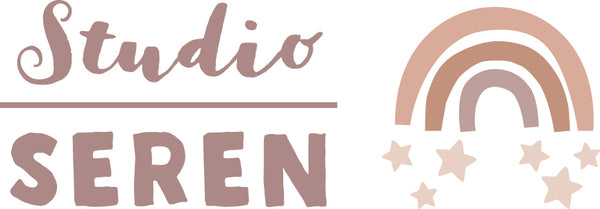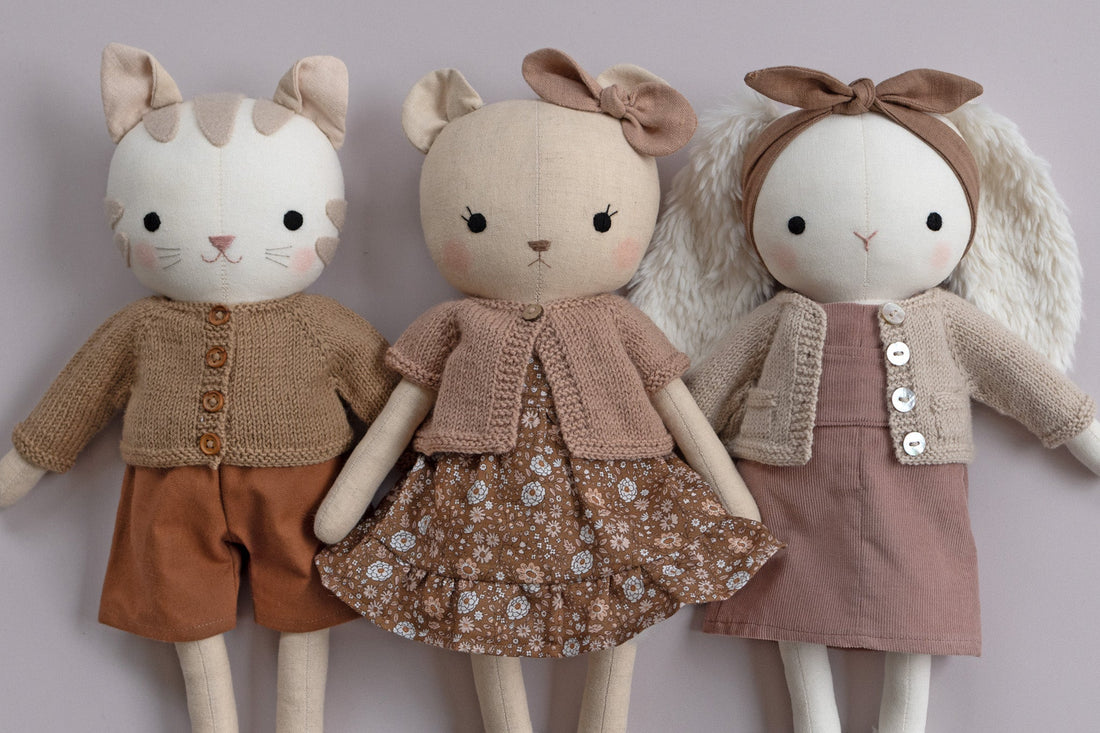Knitting doll clothes is a wonderful way to incorporate another layer of creativity into doll-making. Not to mention, knitted clothes look adorable and make your dolls even more special and unique. With them being small in size, knitting doll clothes offers an opportunity to try new knitting techniques without needing to commit lots of time or money. In this article, I share my tips for knitting doll clothes
Start with our beginner's patterns
If you are new to knitting I recommend that you begin with our knitted accessories part one and two patterns. The accessories are knitted in order of difficulty, taking you on a journey that introduces new techniques along the way, helping you build both your skills and confidence while making adorable accessories like scarves with pom-poms, cute headbands, sweet shoes, and more for your dolls. It's packed full of tips for beginners and includes video demonstrations of knitting techniques that will be used. They are perfect for beginners but also a fun, quick knit for those with more experience
Use the right yarn
Choosing the correct yarn weight is essential for ensuring your doll's clothes fit properly. The weight of the yarn is how thick the yarn is, which impacts the overall look and feel of the finished item. If you use the wrong weight yarn, you risk the clothes looking too bulky on your doll or them being too small to wear
All of the Studio Seren doll clothes knitting patterns are designed to be knitted using 4-ply or fingering-weight yarn. It is the perfect weight for knitting doll clothes because it's fine enough to be shaped so clothes are well-fitted. It also allows you to add little details to clothes, such as pockets, picot edges and lace patterns, transforming them from ordinary to special. Pretty stitch patterns and motifs can be knitted at doll size, adding an extra touch of cuteness!

The great thing about knitting doll clothes is that you only need small amounts of yarn. You might have leftover yarn in your stash that’s perfect for the job. That’s why I include the yardage needed in all the patterns - so if you have a partially used ball of yarn, you can easily determine if you have enough to knit the item
Yarns come in a standard range of sizes, but the names can vary from country to country. The yarn conversion table below can be used to help you find suitable yarn depending on where you live

Staying updated on what yarn is available can be tricky, with manufacturers frequently changing their offerings. Just when you find yarn that works, you can find it is being discontinued. To make things easier for you, there is a post in the Studio Seren customer Facebook group that lists yarns that have been used by me or customers to make the doll clothes knitting patterns, which we will keep adding to as new ones emerge (you are invited to join the group when you order a Studio Seren doll sewing pattern)
You can knit doll clothes with any type of yarn. Use what is available to you within your budget. I like using merino wool because it is soft and stays looking nice for longer, especially if the clothes are being handled a lot. Regular wool can sometimes feel rough and scratchy. Acrylic yarn is affordable and easy to find in a wide range of colours. Cotton, especially the soft natural type, works well. Try to avoid mercerised cotton, which tends to be shiny and more stiff and rigid than natural cotton
Always knit a gauge square
Knitting a gauge square is a way to measure your knitting tension and ensure it matches the tension used to design the doll clothes knitting pattern. If you use the correct gauge, you can be confident that the clothes you are knitting will fit your doll. If you skip knitting a gauge square, you could end up with clothes that are too big or too small for your doll
Three things affect knitting gauge…
- Yarn weight - Thick yarns make bigger stitches and a looser gauge. Thin yarns make smaller stitches and a tighter gauge
- Needle size and type – the bigger the needles, the bigger the stitches. Even what your needles are made from can make a difference. You might get a different gauge using wooden needles than you do using metal ones
- Your natural knitting tension – some knitters knit very tightly, and some knit very loosely. Ask a group of knitters to knit a swatch with the same needles and yarn, and they will all be slightly different sizes!
Whilst it’s difficult to change your natural knitting tension, it’s easy to use different size needles. You can use a smaller knitting needle to get a tighter gauge and a larger knitting needle to get a looser gauge
A gauge square is a small square of knitted fabric used to measure your gauge. Follow the instructions in the pattern for knitting a gauge square using the same yarn, the same needles, and the same type of stitches used for your actual project. If it matches the recommendation in the pattern, you’ve found the right combination!

If your square is too big, try knitting it again using smaller needles. If it is too small, try knitting it again with larger needles
Because of the small size of doll clothes, you may be tempted to knit a smaller gauge square. After all, it is almost as big as the clothes themselves! But accuracy is even more important for doll clothes than regular clothing. A couple of stitches can make a big difference to the fit, and unlike babies and children, dolls won’t grow into their clothes! Once you know you have the correct gauge, you can easily unravel the square and repurpose the yarn for knitting the doll clothes
When it comes to knitting doll clothes, making these small adjustments can make a big difference to your results. Taking the time to fine-tune your gauge will ensure that your clothes fit your doll perfectly
Choose comfortable knitting needles
While you don’t need special needles for knitting doll clothes, the type you choose can make it easier and more comfortable
Knitting needles come in various thicknesses (needle sizes) and lengths. Choosing a shorter size can make knitting doll clothes more enjoyable, especially when using double-pointed needles that typically range from 10-40cm. Smaller lengths, like 10cm or 15cm, are easier to handle and manipulate when knitting rounds with just a few stitches

If you’re new to knitting in the round on small needles, be patient. Avoid holding your needles too tightly, and take breaks every five minutes or so to stretch your hands and relax. You will quickly get used to it.
Bamboo needles are often more comfortable to work with, especially if you are a tight knitter or have painful joints in your hands
Make good use of your yarn tails and sew up seams
When knitting doll clothes, weaving in yarn ends or joining in a new length of yarn to sew up a seam can add unwanted bulk to tiny seams. This is more noticeable in doll-size clothing. Planning is vital for minimising the number of yarn tails you need to sew in
When using the thumb method for casting on, start with extra yarn length than you need so you can use the tail for sewing up. Similarly, leave a generous tail when casting off if it can be used to sew up a seam
Use your favourite method for sewing up seams, but make them as flat as possible by sewing into the very edge of the knitting stitches
Another tip is to strand your sewing yarn or tail end by separating it and using only half the strands for sewing. If you split the tail end, weave the unused strands into the garment away from the seam




Sewing small buttons
The buttons used for doll clothes are naturally smaller than those used for regular clothes. Consequently, the buttonholes you sew through may also be smaller. At times a standard tapestry needle may not fit through the buttonhole, particularly after the initial stitch. If this happens use a smaller tapestry needle (around size 24 or 26) or an embroidery needle. If you are using a smaller needle you can split the yarn into fewer strands to make it easier to thread through the eye of the needle

Whether you are new to knitting doll clothes or you’ve been knitting for a while, I hope these tips are valuable and make your experience easier and more enjoyable
These tips were shared by Julie Taylor from LoveFibres, who is the designer behind the Studio Seren range of doll knitting patterns
LoveFibres offers knitting patterns to make simple, easy-to-wear baby and children’s clothes that can be handed down from one sibling to the next





4 comments
J ai commandé et payé les modele tout est venu en an glais je ne comprend r
ien je suis déçue
J ai commandé et payé les modele tout est venu en an glais je ne comprend rien je suis déçue
Me encanta todo con respecto a muñecas de trapo ,su ropita cosida o tejida ,etc etc todo todo
Oh my gosh this is absolutely amazing. I can’t wait to try this. Thank you so much for sharing. I’m in an avid, but I do not have the capability to make my own pattern so thank you so much for creating this.